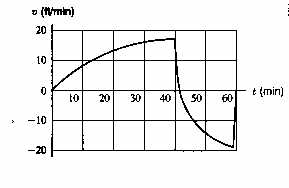Mathematics 136 -- Calculus 2
Discussion 1 -- Integrals and Net Change; Another Application
September 13, 2016
Background
Suppose we apply the Fundamental Theorem, part II to an integral of the form
∫ab f '(x) dx, where the integrand
is the derivative of another function f(x). Then f(x)
will play the role of the antiderivative, and we have
∫ab f '(x) dx = f(b) - f(a)
We will call this the net change of f(x) over the interval
from a to b.
For instance if f(t) represents the
height of a balloon above the ground as a function of time (see question 4 below),
then f '(t) = v(t) is
the balloon's vertical velocity, and
∫ab f '(t) dt = f(b) - f(a)
gives the net change in the height of the balloon from t = a to
t = b.
Discussion Questions
- If w'(t) represents the rate of growth of a child in pounds
per year, explain in words what the value of the integral
∫48 w'(t) dt
represents. (No calculations -- just give a one sentence description of
what the result would mean, in real world terms.)
- The number n(t) of honeybees in a population starts at n(0) = 200
bees and increases at a rate of n'(t) bees per week from the start of the counting
until t = 10 weeks. Write an expression for the number of bees in
the population at the end of the 10 weeks using a definite integral (and anything else
you need).
- If f '(x) represents the slope of a trail at x miles from
the start of the trail, what does the value of
∫26 f '(x) dx
represent in real world terms? (You can assume the trail follows a straight line path if
you like. Also, don't worry about trying to take the curvature of the earth into account!)
- The Montgolfier brothers, Joseph and Etienne, were pioneers in
hot-air ballooning in the late 1700's in France. If they had possessed
appropriate instruments, they might have left a record of one
of their early experiments as shown in the graph below. The graph
shows the vertical velocity v of their balloon as
a function of time t. We want to use the graph of the velocity
to try to estimate the total change in height
over the trip using the information in the graph.

- Over what time intervals was the balloon rising? Over what intervals
was it falling? At what time was the greatest altitude achieved on this trip?
- What apparently happened at t = 40? (Think about how a hot-air balloon
works.)
- What apparently happened right before t = 60?
- Did the balloon end up higher, lower, or at the same
height it started? Explain carefully how can you tell using the value of a definite
integral. Give enough
details to convince a skeptical calculus teacher(!)
Assignment
Group write-ups due in class on Wednesday, September 14.
